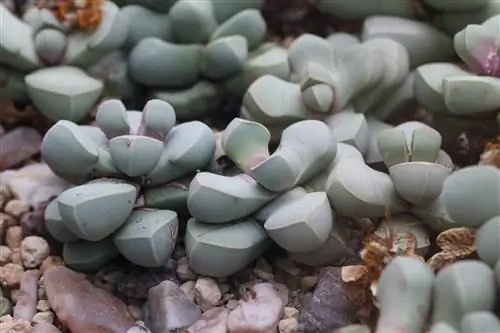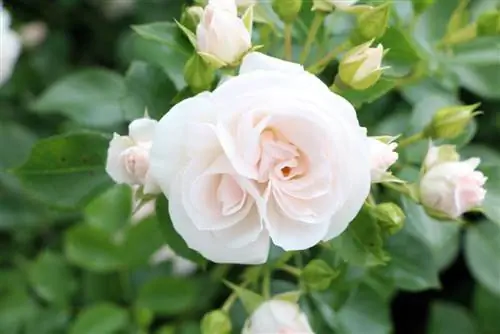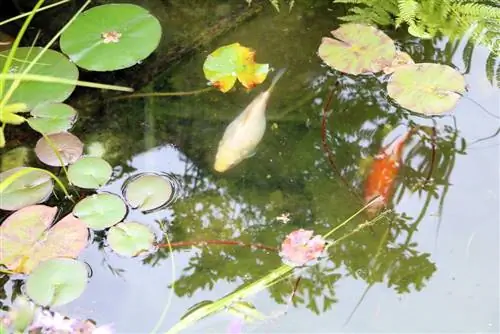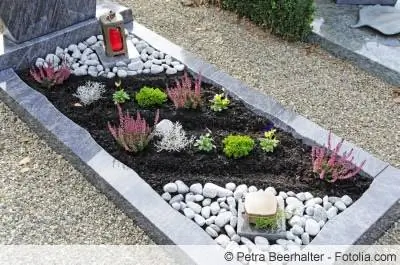- Author admin [email protected].
- Public 2023-12-17 03:39.
- Last modified 2025-01-24 12:45.
The living stones do not look the way you normally imagine plants: very few leaves make them appear half-stunted, they grow in barren environments and yet can last for decades. The well-camouflaged plants originally come from southern Africa, where they use their appearance to protect themselves from predators. Various cultivated species are divided into groups according to the color of the plants and their flowers; hybrid and selected species complement the selection. Lithops are easy to care for.
Substrate
Thanks to their origin in water-scarce southern Africa, the living stones do not require humus-rich soil, but rather a more porous and mineral base. They really like pumice gravel from the Eifel because it is very permeable to water and the grain size of two to four millimeters is ideal for holding the plants. Special substrate can be ordered from specialist retailers; you can usually find everything in the cacti and succulents department. If you don't want to buy substrate, you can mix equal parts compost soil and sharp sand. It is important that a layer of clay shards is laid out in the pot so that excess water can drain away.
Pot
Flat planting bowls are extremely unsuitable for Lithops. In their natural habitat, the plants get water deep from the ground via their long taproots, so they need deep pots that don't hold moisture, but offer access to deep water reservoirs. The pot doesn't have to be wide because living stones don't have long leaves or wide-spread roots. Depth, on the other hand, is important.
Location
From their natural home in southern Africa, the living stones are used to strong, direct sunlight. These plants do not like shade, even partial shade. Lithops feel very comfortable in a place with lots of sun, direct sun and long hours of sunshine every day. The plants grow best in an environment that resembles their natural habitat - which is why the living stones should really be kept in the blazing sun. In winter the plants like a cool and dry place that is airy, bright but not too sunny. The plants should be able to slowly get used to direct sunlight in spring.
Water requirements and watering
Lithops are used to summer downpours and otherwise a lot of drought. The plants have adapted perfectly to their environment; they do not lose much water through evaporation and only have one pair of leaves, which are thick and fleshy and hold the water in the plant. Lithops are watered only when the surface of the soil in the pot has dried. And they can only get enough water to keep the soil moist - more would be more damaging. The amount is good if the upper layers in the pot can dry well before the next watering.
It is generally watered from spring until the end of the flowering period in autumn; there is no water in winter. Because in winter the living stones form a new pair of leaves, and the water required for this is drawn from the old leaves that then die. The plants don't need anything more. Every winter they form exactly a new pair of leaves, and even with watering and fertilizing you can't get the plants to grow more, because this type of plant simply grows that way and no other way.
Fertilize
Living stones are not fertilized. The plants are native to the barren soil of Africa, they get by on few nutrients and don't want any fertilizer. A sandy or stony soil that allows water to drain easily is sufficient for them. Additives that contain more nutrients would be more harmful to the plants because they really draw everything from the water and the rocky ground that they have in their natural environment.
Temperature
Lithops come from a warm environment and need summer warmth. They thrive well at room temperature; if it gets warmer than the usual 18°C in Germany in spring and summer, then this promotes growth. If the plants are kept in the blazing sun on the south window, they not only benefit from the light, but also from the warmth that comes with it. However, it gets very cold at night in southern Africa, and nighttime temperature drops of down to 10° C are not a problem for the plants. If possible, the temperature should not fall below this. In winter, however, during the rest phase, temperatures between 5° and 10° C are sufficient; the plant is now resting and does not need as much heat.
Propagation and offspring
The living stones can be grown from seeds. To form seeds you need two plants whose flowers can pollinate each other. The seed ripens in a capsule that remains tightly closed in dry conditions and sunlight, but is open in humidity and rain. In nature, the water washes out the seeds of the Lithops and carries them away so that new plants can grow. In the living room, the gardener has to do this work and carefully flush the seeds out of the capsule with water. But Lithops can also be propagated by dividing. Closely spaced plants are divided in late spring. The freshly divided living stones should be placed in a bright but not sunny place and watered moderately. In early summer, these plants are already ready to bloom and can be placed in the blazing sun. Living stones grown from seeds, on the other hand, only bloom after a few years.
Editor’s Tip
If you keep your living stones in a porous, mineral substrate and not in a mixture of soil and sand, you can add a little green manure in a very low concentration to the irrigation water during the growing season between June and October. This is not absolutely necessary, but it is good for the plants when used carefully.
Frequently asked questions
The living stones are sold in shallow gravel bowls - should they stay there?
No, they shouldn't. These plants certainly like a substrate that is porous and mineral-rich, but a shallow planting bowl is exactly the wrong place to be. Lithops have long taproots that extend deep into the ground - they require a deep pot to allow enough space for the root.
How are the seeds treated?
The seeds are simply scattered onto the moist substrate, because living stones germinate in light. Temperatures between 15° and 20° C are ideal. The germination time is around five to twenty days, and if the humidity is kept high during germination by putting a glass over it, the plants like that. Mold can be prevented by airing it out once a day.
What you should know about Lithops in brief
Lithops or living stones owe their name to their similarity to pebbles. The interestingly flowering succulent plants belong to the ice plant family, which means that most of them bloom around midday. However, there are also varieties that only open in the evening or even at night. The special thing about the Lithops is that their new leaves break through the old ones.
Location
- The plants like a bright and sunny location and if possible all year round.
- In the hot summer months, however, they should not be exposed to the blazing midday sun.
- Sunburn is shown by discoloration of the upper leaf surfaces.
- If the Lithops spend the summer outdoors, they should be given a place protected from rain.
- Plants also need a lot of fresh air indoors.
- If the humidity is too high, the plant may tear open to the side.
- A build-up of heat in a south-facing window is just as harmful to Lithops as constantly wet feet.
Substrate
- The planting substrate must be well-drained. Normal potting soil is not suitable.
- A high mineral content is beneficial. This can be achieved using sand or small stones.
- A mixture of one third clay-free garden soil, one third sand and one third pumice gravel is best.
- A lava-pumice mixture is also not bad.
- It's best to plant many plants in a bowl, it looks better and the water retention and temperature of the substrate are more stable.
- The planter should be sufficiently deep because the living stones form taproots.
Irrigation
- It is only watered very sparingly. The living stones have water-storing properties.
- When you water, do so until the soil no longer absorbs moisture. Excess water is removed (coaster).
- Wait until the soil has dried out before watering again.
- Too little water doesn't harm the plants, too much is usually fatal.
- While the Lithops are forming leaves, water is administered minimally.
- Too much water can cause it to burst. An injury increases the risk of rot.
- Fertilization is only carried out when the new leaves are fully formed.
- You use cactus fertilizer in half the concentration and once a month.
Pests
- Mealybugs and root lice are possible pests.
- The fungus gnat can also cause damage.
- Mealybugs can be removed mechanically.
- Dried leaf casings must be removed.
- Root lice can be combated by rinsing the roots. Then you plant fresh.
- If spider mites appear, it is best to rinse them off.
- Be careful of snails!






